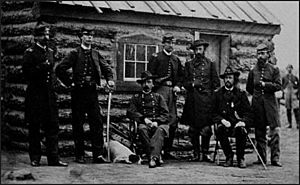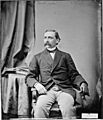Adelbert Ames facts for kids
Quick facts for kids
Adelbert Ames
|
|
|---|---|
 |
|
| 27th and 30th Governor of Mississippi | |
| In office January 4, 1874 – March 29, 1876 |
|
| Lieutenant | Alexander K. Davis |
| Preceded by | Ridgley C. Powers |
| Succeeded by | John M. Stone |
| In office June 15, 1868 – March 10, 1870 |
|
| Preceded by | Benjamin G. Humphreys |
| Succeeded by | James L. Alcorn |
| United States Senator from Mississippi |
|
| In office February 23, 1870 – January 10, 1874 |
|
| Preceded by | Jefferson Davis Secession (vacant until 1870) |
| Succeeded by | Henry R. Pease |
| Personal details | |
| Born | October 31, 1835 East Thomaston (now Rockland), Maine, U.S. |
| Died | April 13, 1933 (aged 97) Ormond Beach, Florida, U.S. |
| Resting place | Hildreth Family Cemetery in Lowell, Massachusetts 42°39′39″N 71°18′36″W / 42.660798°N 71.309928°W |
| Political party | Republican |
| Spouse |
Blanche Butler
(m. 1870) |
| Relations | Benjamin Franklin Butler (father-in-law) |
| Children | Butler, Edith, Sarah, Blanche, Adelbert Jr., Jessie |
| Alma mater | United States Military Academy |
| Profession | Military |
| Military service | |
| Allegiance | United States |
| Branch/service | U.S. Army (Union Army) |
| Years of service | 1861–1870 1898–1899 |
| Rank | |
| Unit | 5th United States Artillery |
| Commands | 20th Maine Volunteer Infantry 2nd Brigade, 1st Division, XI Corps 2nd Division, X Corps 2nd Division, XXIV Corps Fourth Military District 3rd Brigade, 1st Division, Fifth Army Corps 1st Division, Fifth Army Corps |
| Battles/wars | American Civil War Spanish–American War |
| Awards | Medal of Honor |
Adelbert Ames (born October 31, 1835 – died April 13, 1933) was an important American figure. He was a sailor, a brave soldier, and a politician. He served as a general in the Union Army during the American Civil War.
After the war, Ames became a key leader in Reconstruction-era Mississippi. He was a military governor, a U.S. Senator, and later the civilian governor of the state. He was a member of the Radical Republican party, which worked to protect the rights of newly freed slaves.
In 1898, he served again as a general during the Spanish–American War. Ames was the last Republican governor of Mississippi until 1992. He lived to be 97 years old, making him one of the last Civil War generals to pass away.
Contents
Early Life and Education
Adelbert Ames was born in 1835 in Rockland, Maine. His father, Jesse Ames, was a sea captain. Adelbert also became a sailor, working on his father's ships.
In 1856, he joined the United States Military Academy in West Point. He was a very good student, graduating fifth in his class in May 1861. This was an early graduation because the Civil War had just begun.
Serving in the Civil War
Ames started his military career as a second lieutenant in the artillery. Just eight days later, he was promoted to first lieutenant.
First Battle of Bull Run
During the First Battle of Bull Run in July 1861, Ames was badly wounded in his right leg. Even though he was hurt, he refused to leave his cannons. For his bravery, he was promoted to major. Later, in 1893, he received the Medal of Honor for his actions in this battle.
Peninsular Campaign and Promotions
Ames returned to duty the next spring. He fought in the Peninsular Campaign, including battles at Yorktown, Battle of Gaines' Mill, and Battle of Malvern Hill. His actions at Malvern Hill earned him another promotion to lieutenant colonel.
He soon realized that becoming an infantry officer offered more chances for promotion. So, he went back to Maine and became the commander of the 20th Maine Volunteer Infantry Regiment in August 1862.
Battles with the 20th Maine
The 20th Maine fought in the Maryland Campaign and at the Battle of Antietam. They also fought in the difficult Battle of Fredericksburg in December 1862. During the Battle of Chancellorsville in May 1863, Ames volunteered to help Major General George Meade.
Becoming a General
Because of his good work, Ames was promoted to brigadier general in May 1863. He then took command of a brigade in the XI Corps. He handed over command of the 20th Maine to Lieutenant Colonel Joshua Chamberlain, who would become famous at the Battle of Gettysburg.
Ames also fought bravely at Gettysburg. His division faced a strong attack on July 1, 1863. His commander was wounded, so Ames took over the division. He led them in a retreat through Gettysburg to Cemetery Hill. On July 2, his tired division held off another major attack on East Cemetery Hill. Ames even joined in the hand-to-hand fighting to defend the position.
Later War Service
After Gettysburg, Ames was promoted to colonel in the regular army. His division moved to South Carolina and Florida. In 1864, his division joined the X Corps and fought in the Bermuda Hundred Campaign and the Siege of Petersburg. Later, he would become the son-in-law of his commander, Major General Benjamin Butler.
Ames led a successful attack at the Second Battle of Fort Fisher. He went with his men into the enemy fort, even as many of his staff were shot. For his bravery, he was promoted to major general in March 1865.
Politics in Mississippi
In 1868, Congress appointed Ames as the temporary governor of Mississippi. He worked to help formerly enslaved people, appointing the first black officials in the state. This was a challenging time, as there was much violence against black citizens and their supporters.
Becoming a Senator
In 1870, the Mississippi Legislature elected Ames to the United States Senate. He served as a Republican senator until 1874. In Washington, D.C., he met and married Blanche Butler, the daughter of his former commander, Benjamin Butler. They had six children.
As a senator, Ames became a skilled public speaker. He resigned from the Senate when he was elected governor of Mississippi.
Governor of Mississippi
Ames ran for governor in 1873 against James Lusk Alcorn, another Republican. Ames won with the support of many black voters and some white Republicans.
As governor, Ames tried to reduce government spending and lower taxes. He was known for being honest and fair. However, he faced many challenges from Democrats who wanted to end Reconstruction.
In 1874, there was violence in Vicksburg, Mississippi, known as the Vicksburg Massacre. Ames asked the federal government for troops to help. He also tried to create a state militia, but it was difficult.
Democrats used tactics like threats and violence to stop Republican voters in the 1875 elections. This was called the "Mississippi Plan." They gained control of the state legislature. In 1876, the legislature tried to remove Ames from office. Even though they couldn't prove he did anything wrong, he knew he would be removed. To avoid a costly trial, Ames agreed to resign on March 29, 1876, if all charges were dropped.
Later Life and Legacy
After leaving office, Ames moved to Minnesota and joined his family's flour-milling business. Later, he moved to Massachusetts and continued in business.
In 1898, Ames served again as a brigadier general in the Spanish–American War in Cuba. He fought in the Battle of San Juan Hill and commanded a brigade during the Siege of Santiago.
Ames died in 1933 at the age of 97 in Florida. He was the last surviving full-rank general from the Civil War. He is buried in the Hildreth family cemetery in Lowell, Massachusetts.
Family Connections
Ames was the son-in-law of Civil War General Benjamin Butler.
His daughter, Blanche Ames Ames, was a famous supporter of women's rights, an inventor, and an artist. His son, Adelbert Ames Jr., became a well-known scientist. Another son, Butler Ames, was a businessman and served in Congress.
Adelbert Ames was also the great-grandfather of writer George Plimpton.
In Memoriam

A special plaque honoring Ames's Medal of Honor was placed at his grave in 2009.
Ames Hill Castle
In 1906, Ames built a large house in Tewksbury, Massachusetts, known as "the Castle." This house was later bought by a developer and eventually torn down to make way for new homes. However, it was recognized as an important historical building before its demolition.
In Popular Culture
Adelbert Ames was played by actor Matt Letscher in the 2003 movie Gods and Generals.
See Also
- List of American Civil War generals (Union)
- List of Medal of Honor recipients for the American Civil War
- List of U.S. state governors
Images for kids




